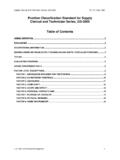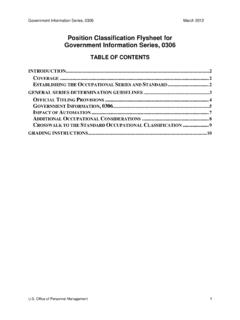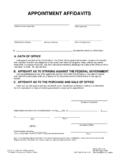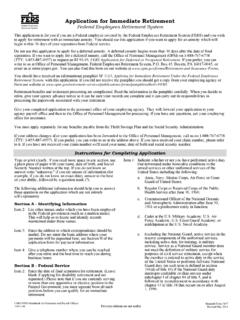Transcription of Position Classification Standard for Supply Clerical and ...
1 Supply Clerical and technician series , GS-2005 TS-115 May 1992 Position Classification Standard for Supply Clerical and technician series , GS-2005 Table of Contents series 2 EXCLUSIONS .. 2 OCCUPATIONAL INFORMATION .. 2 DISTINGUISHING BETWEEN Supply technician AND Supply SPECIALIST 4 TITLING .. 5 EVALUATING POSITIONS .. 5 GRADE CONVERSION TABLE .. 6 FACTOR LEVEL 6 FACTOR 1, KNOWLEDGE REQUIRED FOR THE Position .. 6 FACTOR 2, SUPERVISORY 10 FACTOR 3, GUIDELINES .. 11 FACTOR 4, 12 FACTOR 5, SCOPE AND 13 FACTOR 6, PERSONAL CONTACTS AND .. 14 FACTOR 7, PURPOSE OF CONTACTS .. 14 FACTOR 8, PHYSICAL 15 FACTOR 9, WORK ENVIRONMENT ..15 Office of Personnel Management 1 Supply Clerical and technician series , GS-2005 TS-115 May 1992 series DEFINITION This series includes positions involved in supervising or performing Clerical or technical Supply support work necessary to ensure the effective operation of ongoing Supply activities.
2 It requires knowledge of Supply operations and program requirements and the ability to apply established Supply policies, day-to-day servicing techniques, regulations, or procedures. EXCLUSIONS 1. Classify positions in the appropriate Supply management or operations series ( general Supply , GS-2001; Supply Program Management, GS-2003; Inventory Management, GS-2010; Distribution and Storage Facilities Management, GS-2030; or Packaging, GS-2032) when they require substantive knowledge of Supply management concepts, principles, and techniques, and the ability to make decisions in cases not specifically covered by substantive guides or precedents. 2. Classify positions in an appropriate series when specialized skills such as typing, stenography, or dictating machine transcription are required to perform the Clerical work.
3 3. Classify positions in the Clerical support series appropriate for the subject matter when the primary requirement is for knowledge of the subject matter, other than Supply , in the area supported. 4. Classify positions in the appropriate series in the Accounting and Budget Group, GS-0500 when the accounting or budget skills are the primary requirements for staffing the positions. 5. Classify positions in the appropriate Federal Wage System series when they are primarily concerned with unskilled, semi- skilled, or skilled manual labor work where the base or paramount requirements relate to the physical handling of stock. OCCUPATIONAL INFORMATION Supply clerks and technicians perform work in a wide range of systematized Supply operations, such as performing records functions in inventory, storage, cataloging, and receipt and control processes.
4 Employees typically do work associated with one of the Supply management or operations processes. Some employees, however, do work at local installations involving elements of several Supply programs. Supply clerks and technicians perform one o r more of the following kinds of work: -- oversee stock maintenance at or within prescribed levels and establish or adjust stock levels and reorder points using Standard formulae and prescribed procedures; Office of Personnel Management 2 Supply Clerical and technician series , GS-2005 TS-115 May 1992 -- conduct physical inventories and adjust and/or maintain inventory, stock, plant, or property account records; -- receive and screen lists or other documents specifying supplies or materials needed for planned programs or work operations, and collate and assemble lists of equipment and parts needed for acquisition plans.
5 -- initiate, prepare, edit, and process requisitions to stock, commodity control, or other appropriate Supply organizations; -- search catalogs, records, or other data sources to obtain or correct stock numbers or to find authorized substitutes for stock items; -- contact customers, Supply organizations, transportation units, and others to obtain material status information, follow up on urgently required items, and/or expedite delivery of material to work sites; -- process documentation for stock item receipts, maintain such items in a Supply room or similar storage area, issue material to shop or work center personnel, keep local stock records, reorder when stocks are low or at a specified reorder point, prepare Standard reports such as variances between actual and estimated costs, and perform related stock receipt, storage, control, and issue functions for expendable and non-expendable items for a local organization; -- identify requirements and requisition, issue, or distribute office and administrative supplies, forms, publications, or other printed materials; -- maintain an accurate accounting and reporting system for non-expendable property and perform standardized property management control processes.
6 And/or -- operate computer terminals or personal computers to perform records search, data input, and data corrections. A Supply "item" as used in this Standard is a generic term. It may refer to supplies, equipment, material, property (except real property), publications, and certain related services. Scope or size of the organization served does not itself influence the grade level of Supply Clerk or technician positions. They operate in any kind of organizational entity, at any level. They may be found, for example, in an operating office serving the consumer, in an agency headquarters Supply office, in the Supply office of a local field establishment, or in a system-wide national inventory control point. Virtually all Supply systems are automated. Supply clerks and technicians must have sufficient knowledge of the automated systems to apply instructions for Supply actions such as data entry, reports retrieval, error correction, and searching for specific records.
7 The work is performed through terminal stations and/or personal computers. Employees maintain specified sets of Office of Personnel Management 3 Supply Clerical and technician series , GS-2005 TS-115 May 1992 records in general Supply operations or in support of one of the specialized Supply functions ( , inventory, cataloging, etc.) and are responsible for keeping them both accurate and current. DISTINGUISHING BETWEEN Supply technician AND Supply SPECIALIST POSITIONS There are several areas to review in determining whether positions are to be classified to the Supply Clerical and technician series , GS-2005, or to a series covering Supply specialist functions (GS-2001, 2003, 2010, 2030, or 2032). Careful consideration must be given to (a) the duties and responsibilities of the Position , including the supervision received, (b) the knowledge and abilities required to perform the work, and (c) the recruitment sources, career ladder, and needs of management.
8 For example: a. Supply technicians generally follow established methods and procedures which have been developed by Supply specialists or management personnel. They are primarily concerned with the application of these guidelines to specific Supply problems or situations. Occasionally, they may develop individualized work plans or procedures, but these typically are limited to the individual situations with which they work (such as determining reasons for computer rejections). b. Supply technicians perform assignments (1) requiring less extensive knowledge of programs, operations, or organizations serviced ( , they relate to functions that are stable or standardized, functions of complex programs, to local needs, or to individual case problems or Supply actions); and/or (2) requiring a limited knowledge of item characteristics or technical uses of items of Supply or equipment.
9 Decisions are made by applying established methods or techniques; by drawing on a knowledge of appropriate precedents; or by obtaining guidance and instructions from a Supply specialist. c. Supply technicians may perform some of the same work tasks as the Supply specialist, but they do so based on practical experience and familiarity with Supply operations, the Supply mission of the organization, and Supply regulations, policies, procedures, and directives. Supply specialists such as Supply systems analysts, inventory management specialists, Supply catalogers, etc., are responsible for planning and developing the Supply system, programs, or services; and for developing, adapting, or interpreting operating methods or procedures. Supply specialists perform assignments requiring a deeper knowledge and understanding of programs and the needs and operations of the organizations serviced.
10 For example, the Supply specialists (1) must apply a knowledge of present and proposed programs, program changes, work operations, work sequences and schedules; and/or (2) must have a greater knowledge of the technical characteristics or properties of Supply items. This knowledge is required to plan and forecast inventory needs under changing technological or program requirements; efficiently distribute or phase materiel support to accomplish mission requirements; effectively manage and Office of Personnel Management 4 Supply Clerical and technician series , GS-2005 TS-115 May 1992 utilize Government-owned property under changing program requirements; or clearly identify and describe difficult technical items within a cataloging system. Specialists apply judgment in analyzing needs that go beyond the application of guidelines to resolve specific Supply problems.
















